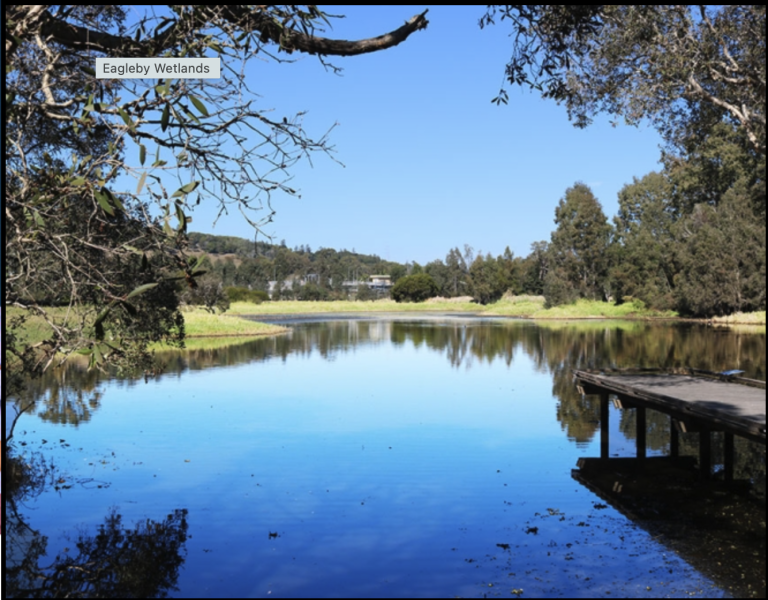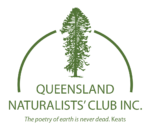
Excursion Report – Eagleby Wetlands held 22 June 2024
Leaders: Judy Haines & Cathie Duffy
Queensland Naturalists’ Club morning outing to the Eagleby Wetlands, Logan City led by Judy & Cathie. After a wet summer it has been a dry June. A cold and overcast morning greeted 16 members to a slow saunter around the wetlands.
For bird observations see eBird trip report: https://ebird.org/tripreport/254241
For iNaturalist observations: https://inaturalist.ala.org.au/projects/qnc-2024-jun-eagleby-wetlands
Judy Haines writes “ This almost winter solstice day dawned grey, cloudy and cold with a threat of showers to come as a dozen or so ‘Nats’ hauled themselves out for an early meeting, well 8.30 – early enough, at Eagleby Wetlands. Privately I was worrying that the bleak weather would keep the birds skulking silently out of sight so we planned two routes along the multiple paths, firstly a short loop back to the car park for warming coffee and sustenance (and an honorable exit for people who had had enough) and a longer loop afterwards for the true, gritty ‘Nats’. In the event, no one wanted an early pass and so we meandered both loops, finding plenty to marvel at on the way.
Birds were surprisingly abundant with especially delightful views of two separate pairs of Striated Pardalotes attending nests in tree cavities and their incessant calls, along with the cheerful, varied songs of Brown Honeyeaters which accompanied us all the way. There were short sightings of Swamp Harriers and a Whistling Kite. The para grass swamps, overlooked by hides, had much activity with Sacred Kingfisher, Bar-shouldered Dove and Golden Headed Cisticola, (and a Spotless Crake was heard.) There were good views of Hardheads, Pacific Black Duck and Australasian Grebe on the river and the malodorous sewage pond and Rainbow Bee-eaters, Rufous Fantail and numerous Grey Fantails hawked for insects in the Melaleuca swamp.
As well as very knowledgeable birders, we were fortunate to have with us experts in insects, Protozoa, algae and mistletoe, so we were alerted to the elaborate galls of scale insects, the topic of a recent QNC talk, handsome specimens of mistletoe and, almost immediately on our return home, microscopy images of single celled organisms. Thus the joy of an excursion continues in the comfort of our homes as we review these and iNaturalist and e-bird lists from the day.
The Wetlands consists largely of Broad-leaved Paperbark, Melaleuca quinquinervia swamp with magnificent Queensland Blue Gums, Eucalyptus tereticornis, many in full flower and swarming with Rainbow Lorikeets. The lagoons are almost closed over with Para grass (Brachiaria mutica) but water birds can be seen on the open stretches of the Albert River and the water treatment pond. Freshwater swamp plants could be easily accessed for identification: Velvet Knotweed, Persicaria attenuate, Golden Bladderwort, Utricularia aurea, Giant Sedge, Cyperus exaltatus, Native Willow Primrose, Ludwigia octovalvis and False Daisy, Eclipta prostrata. Other less usual native plants were Melastoma, Melastoma malabrathicum, Long-flowered Mistletoe, Dendrophthoe vitellina and Slender Cucumber, Zehneria cunninghamii.
Invertebrates were out and about with positive identifications on Black Jezebel, Delias nigrina, Australian Garden Mantis, Orthodera ministralis, Eight-spotted Leaf Beetle, Paropsisterna sexpustulata(!) Variable Lynx Spider, Oxyopes variabilis and many others which you can check out on iNaturalist under QNC Project Eagleby Wetlands.
Samples subjected to microscopy I am reliably informed were revealed as Gonatozygon monotaenium, Actinotaenium turgidum and Neotessella volvocina (no common names) as well as others which you can see on iNaturalist.
Altogether a productive and interesting day despite its dismal appearance. Thank you to all participants for your knowledge and enthusiasm.”
